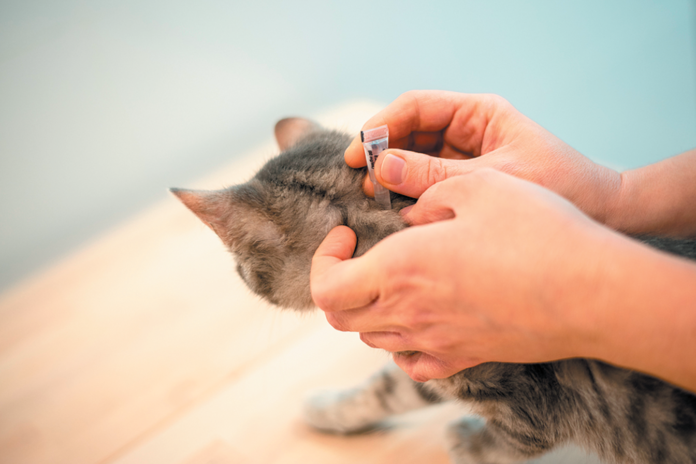One out of every three people reading this sentence does not give their cat flea and tick medicine regularly, according to a study conducted by the Harris Poll. Those owners assume that because their cat doesn’t go outside, their pet doesn’t need it. Or they believe fleas and ticks are a threat just in warm weather. If only these things were true.
Even strictly indoor cats need to be protected from fleas and ticks, say veterinary dermatologists, including Tufts veterinary dermatologist Ramón Almela, DVM. “Owners commonly ask why their pet needs to be protected if it always stays in the house,” he says. But both types of insects are like hobos that hop trains; when you (or your dog) come in from outside, they can jump off and grab a ride on your feline friend.
Furthermore, cats need be protected every single day of the year — even, say, in northern Vermont in the dead of winter. While fleas thrive in warm weather, their pupae — the form they take while transforming from larvae into mature insects — can remain dormant until conditions are right for them to develop and emerge from their cocoons. And, frankly, conditions are pretty much always right because people keep the “weather” in their house warm throughout the winter months.
It’s serious business. Fleas can make a cat very itchy and uncomfortable, to the point that they bite themselves frantically and incessantly or groom almost non-stop. Fleas can also produce allergic reactions. The saliva injected into a cat’s skin during a flea bite is at the root of the hypersensitivity. In addition, fleas can transmit tapeworms to cats, which attach to their small intestines and can lead to gastrointestinal issues. And some cats, especially kittens, may develop anemia resulting from the blood loss that comes with flea bites.
Ticks, for their part, can impart all kinds of other diseases. They feed off animals ranging from mice to deer, which carry infectious agents. One bite from a tick, and a cat can end up with any number of tick-borne illnesses. Among them: Lyme disease. Another is called babesiosis. It causes everything from fever to swollen lymph nodes. Yet another is haemobartonellosis, which targets a cat’s red blood cells, paving the way for weakness and loss of appetite.
Choosing a flea and tick preventative
Flea and tick preventatives come in three different forms: as topicals, collars, or pills.
Topicals, or spot-ons, are the most commonly used ammunition against the harmful insects. They are typically applied on the back, between the shoulder blades, with a little pipette that comes with the package. You have to apply them once a month in most cases in order for them to keep killing the bugs. They sink into the skin and then spread beneath it but lose their effectiveness after 30 days.
Among the brands we trust: Bravecto (can be used every 3 months for fleas and most types of ticks instead of every 30 days), Frontline, Vectra 3D, and Revolution Plus.
Pills, like topicals, have to be given every 30 days in most cases. They tend to work very quickly to kill adult fleas, but many cats are not cooperative when it comes to accepting things to swallow. In addition, no pill for cats covers fleas and ticks, Dr. Almela says.
Among the brands we trust: Comfortis (chewable).
Collars, although more expensive than spot-ons and pills, work for several months at a time.
Among the brands we trust: Seresto. It kills fleas and repels ticks for 8 months. It also has a breakaway mechanism. If the collar gets caught on something, it will release for your cat’s getaway.
If fleas end up around your home as well as on your cat, it’s not because you did anything wrong. Here and there, fleas happen. International Cat Care (icatcare.org) recommends taking the following steps:
- Vacuum frequently. And immediately dispose of the vacuum bags, or clean the canister.
- Use a flea insecticide to eradicate fleas in your home that are not yet mature. Focus on soft furnishings, carpet pile, gaps between floorboards, and other difficult-to-reach areas. Vacuum-clean first.
- Repeat. Flea cocoons (pupae) are particularly resistant to eradication. In some cases it may take a few weeks or even a few months to fully eradicate the problem, but if you keep at it, it will happen.




